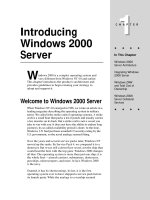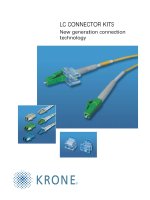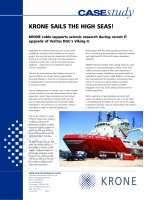Tài liệu Chapter-21-The Domain Name Service doc
Bạn đang xem bản rút gọn của tài liệu. Xem và tải ngay bản đầy đủ của tài liệu tại đây (205.67 KB, 21 trang )
2Apr il 2003, 17:00:47 The Complete FreeBSD (dns.mm), page 363
21
The Domain Name
Ser vice
In this chapter:
• Domains and zones
• Setting up a name
ser ver
• PassiveDNS usage
• Name serverona
standalone system
• Name serveronan
end-user networ k
• Reverse lookup
• Slave name servers
• The next leveldown:
delegating zones
• Messages from
named
• Upgrading a Version
4configuration
• Looking up DNS
infor mation
• Checking DNS for
correctness
• DNS security
In this chapter:
• Domains and zones
• Setting up a name
ser ver
• PassiveDNS usage
• Name serverona
standalone system
• Name serveronan
end-user networ k
• Reverse lookup
• Slave name servers
• The next leveldown:
delegating zones
• Messages from
named
• Upgrading a Version
4configuration
• Looking up DNS
infor mation
• Checking DNS for
correctness
• DNS security
Ever since the beginning of the ARPAnet, systems have had both names and IP addresses.
UNIX systems, as well as manyothers who have copied the BSD IP implementation,
used the file /etc/hosts to convert between names and addresses. This file contains a list
of IP addresses and the corresponding host names, one per line.
It’sclearly impossible to have an /etc/hosts file that describes the complete Internet.
Even if you had disk space, the number of updates would overload your network. The
solution is a distributed database, the Domain Name System,orDNS.The most common
implementation of DNS is BIND,the BerkeleyInternet Name Domain.
1
You’ll notice the
word Berkeley in there. BIND is part of BSD, and it’sabout the only game in town.
Despite these names, the daemon that performs the resolution is called named (the name
daemon,pronounced ‘‘name-dee’’).
DNS provides the information needed to connect to remote systems in the form of
Resource Records,orRRs. Unfortunately,the names of the records aren’toverly
intuitive.
• A(Address) records translate host names to IP addresses. Forexample, one A record
tells you that www.FreeBSD.org (currently) has the IP address 216.136.204.117.
These are what most people think of when theyhear the name DNS. The name
specified in the A record is called the canonical name of the interface, and it should
be the one to which the PTR record (see below) refers.
1. Does this sound likeanacronym in search of a name?
dns.mm,v v4.17 (2003/04/02 03:15:05) 363
The Complete FreeBSD 364
2April 2003, 17:00:47 The Complete FreeBSD (../tools/tmac.Mn), page 364
• PTR (Pointer) records provide a translation from IP address to name. This process is
also called re verse lookup.
• MX (Mail Exchange) records specify the IP addresses of mail servers for a domain.
• SOA(Start Of Authority) records define zones,which roughly correspond to domains.
We’lllook at the distinction between zones and domains below.
• NS (Name Server) records describe name servers for a zone.
• HINFO (HardwareInformation) records describe the hardware and software that
runs on a particular system.
• CNAME (Canonical Name) records describe alternative names for a system.
FreeBSD allows you to use both /etc/hosts and DNS. One reason for this might be to
have name resolution of local hosts at startup time: there’sachicken-and-egg problem
with mounting NFS file systems before named is running.
The common objections to using DNS include:
• It’ssupposedly difficult to set up DNS configuration files.
• DNS supposedly generates a lot of network traffic.
• DNS supposedly causes a dial-on-demand system to dial all the time.
These statements are all untrue. We’lllook at them in the rest of this chapter as we set up
DNS for our reference network.
Domains and zones
In Internet parlance, a domain is a group of names ending with a specific domain name.
We looked at domain names in Chapter 18, Connecting to the Internet,page 318. Note
that, likefile names, there are twokinds of domain names:
• A fully qualified domain name (FQDN)ends in a period (.). This domain name
relates to the root domain. (a single period).
• A relative domain name relates to the current domain. You’ll see them occasionally
in the configuration files.
Most times, when you write a domain name, you intend it to be fully qualified. But if
you write it without the terminating period, DNS will frequently append your own
domain name. Forexample, if you specify a name like freebie.example.org,DNS won’t
find a fully qualified name: it’samisspelling of freebie.example.org..Asaresult, it will
look for the name freebie.example.org.example.org.Itwon’tfind it, of course, but it may
spend a long time trying. The moral is simple: when writing DNS configuration files,
always put a period (full stop) at the end of names that are fully qualified.
dns.mm,v v4.17 (2003/04/02 03:15:05)
365 Chapter 21: The Domain Name Service
2April 2003, 17:00:47 The Complete FreeBSD (../tools/tmac.Mn), page 365
Zones
In manyways, a zone is the same thing as a domain: it’sthe subset of the DNS name
space that is maintained by a specific set of name servers—in DNS-speak, name servers
are authoritative for the zone. The difference is mainly in the way it’sused. There is one
exception, however: usually,asubdomain will have a different name server.This
subdomain is part of the domain, but not of the zone.
Forexample, in our reference network, the name servers on freebie and presto are
authoritative for example.org.The owner of the domain might give permission for
somebody,maybe in a different country,torun a subdomain china.example.org,with
name servers beijing.china.example.org and xianggang.china.example.org.Because there
are different name servers, there are twozones: freebie.example.org would be authorita-
tive for the zone example.org,but not for china.example.org. beijing.china.example.org
and xianggang.china.example.org would be authoritative for the zone china.example.org,
butnot for example.org.
Setting up a name server
DNS service is supplied by the name daemon,called named. named can be run in a
number of different modes. In this chapter,we’ll concentrate on setting the appropriate
configurations for our reference network. If you want to go further,check the following
documents:
• The BIND Online Documentation,inthe source distribution in the directory
/usr/src/contrib/bind/doc/html/index.html.
• TCP/IP Network Administration,byCraig Hunt (O’Reilly).
• DNS and BIND,byPaul Albitz and Cricket Liu (O’Reilly).
In the last fewyears, BIND has undergone some significant changes, mainly as a result of
abuse on the net. The current release is Version 9, but FreeBSD still ships with Version 8.
The differences are relatively minor: Version 9 introduces a number of newfeatures, but
the contents of this chapter should also apply to Version 9. The previous version was
Version 4, and you’ll still find a lot of old documentation referring to it. There were no
Versions 5, 6 or 7, and the main configuration file changed its format completely in
Version 8; eventhe name changed. We’lllook at howtoconvert the formats on page 381.
Before using the documentation above,makesure that it refers to the correct version of
BIND.
dns.mm,v v4.17 (2003/04/02 03:15:05)
Setting up a name server366
2April 2003, 17:00:47 The Complete FreeBSD (../tools/tmac.Mn), page 366
Passive DNS usage
Not every system needs to run its own name daemon. If you have another machine on the
same network, you can send requests to it. Forexample, in the reference network, freebie
and presto may be running name servers. There’snoparticular reason for bumble and
wait,both presumably slower machines, to do so as well. Instead, you can tell them to
use the name servers on the other twomachines.
To dothis, makesure that you don’tenable named in your /etc/rc.conf,and create a file
/etc/resolv.conf with the following contents:
domain example.org
nameserver 223.147.37.1 #freebie
nameserver 223.147.37.2 #presto
Specify the IP addresses, not the names, of the name servers here. This is a classic
chicken-and-egg problem: you can’taccess the name server to get its address until you
knowits address.
With this file in place, this machine will send all name server requests to freebie or presto.
We’lllook at howtoconfigure them later.
Name server on a standalone system
If you only have a single machine connected to the network, and your own machine is
part of the ISP’szone, you can use the resolv.conf method as well. This is a fairly typical
situation if you’re using a PPP or DSL link. It’sstill not a good idea, however. Every
lookup goes overthe link, which is relatively slow. The results of the lookup aren’t
stored anywhere locally,soyou can end up performing the same lookup again and again.
DNS has an answer to the problem: save the information locally.You can do this with a
caching-only name server.Asthe name suggests, the caching-only name server doesn’t
have any information of its own, but it stores the results of anyqueries it makes to other
systems, so if a program makes the same request again—which happens frequently—it
presents the results much more quickly on subsequent requests. Set up a caching-only
name server likethis:
• Either rename or remove /etc/resolv.conf,and create a newone with the following
contents:
nameserver 127.0.0.1 local name server
• Put this line in /etc/rc.conf :
named_enable="YES" # Run named, the DNS server (or NO).
If /etc/rc.conf doesn’texist, just create one with this content.
dns.mm,v v4.17 (2003/04/02 03:15:05)
367 Chapter 21: The Domain Name Service
2April 2003, 17:00:47 The Complete FreeBSD (../tools/tmac.Mn), page 367
• Create a file /etc/namedb/localhost.rev containing:
$TTL 1d
@INSOA @host@. root.@host@. (
@date@ ; Serial
1h ; Refresh
5m ; Retry
100d ; Expire
1h ) ;Negative cache
IN NS @host@.
1INPTR localhost.@domain@.
We’lllook at the meaning of this file in the next section. To create it, you can start
with the file /etc/namedb/PROT O.localhost.rev,which contains a template for this
file. Replace @host@ with the FQDN of your host (freebie.example.org in this
example), @date@ (the serial number) with the date in the form yyyymmddxx,where
xx are a small integer such as 01,
1
and @domain@ with example.org..Makesure that
the FQDNs end with a trailing period. Alternatively,you can run the script
/etc/namedb/make-localhost.
• Edit the file /etc/namedb/named.conf to contain:
options {
directory "/etc/namedb";
forwarders {
139.130.237.3; 139.130.237.17;
};
zone "0.0.127.in-addr.arpa" {
type master;
file "localhost.rev";
};
/etc/namedb/named.conf should already be present on your system as well. It
contains a lot of comments, but at the end there’sa similar zone definition, which you
can edit if you want. The addresses 139.130.237.3 and 139.130.237.17.are the
ISP’sname server addresses. The forwarders line contains up to ten name server
addresses.
• Start named:
# ndc start
1. We’lllook at the serial number on page 368.
dns.mm,v v4.17 (2003/04/02 03:15:05)
Name serveronastandalone system 368
2April 2003, 17:00:47 The Complete FreeBSD (../tools/tmac.Mn), page 368
Name server on an end-user network
Of course, a simple caching-only name server won’twork when you have your own
domain. In fact, most of the authorities who allocate domain names won’tevenlet you
register an Internet domain unless you specify twofunctional name servers, and they’ll
check them before the registration can proceed. In this section, we’ll look at what you
need to do to run a ‘‘real’’name server.
The first thing we need to do is to create a zone file for our zone example.org.We’ll put
it and all other zone files in a directory /etc/namedb and call it /etc/namedb/db.exam-
ple.org after the name of the zone it describes.
The SOArecord
The first thing we need is a record describing the Start of Authority.This defines a new
zone. Write:
$TTL 1d
example.org. IN SOA freebie.example.org. grog.example.org. (
2003031801 ; Serial (date, 2 digits version of day)
1d ; refresh
2h ; retry
100d ; expire
1h ) ; negative cache expiry
The first line, $TTL 1d,isrelatively new. It’snot strictly part of the SOArecord, but it’s
nowrequired to fully define the SOA. It specifies the length of time that remote name
servers should cache records from this zone. During this time theywill not attempt
another lookup. In older versions of BIND, this value was stored in the last field of the
SOArecord below.
The remaining lines define a single SOArecord. the name on the left is the name of the
zone. The keyword IN means Internet,inother words the Internet Protocols. The BIND
software includes support for multiple network types, most of which have now been
forgotten. The keyword SOA defines the type of record. freebie.example.org is the master
name server.
The next field, grog.example.org,isthe mail address of the DNS administrator.‘‘Wait a
minute,’’ you may say,‘‘that’snot a mail address. There should be an @ there, not a ..’’
That’sright, but unfortunately DNS uses the @ sign for other purposes, and it would be a
syntax error in this position. So the implementors resorted to this kludge. To generate
the mail ID, replace the first. with an @,togiv e you
The serial number identifies this version of the zone configuration. Remote name servers
first retreive the SOArecord and check if the serial number has incremented before
deciding whether to access the rest of the zone, which could be large. Makesure you
increment this field every time you edit the file. If you don’t, your updates will not
propagate to other name servers. It’sagood idea to use a format that reflects the date, as
here: the format givesfour digits for the year,two digits for the month, twofor the day,
and twofor the number of the modification on a particular day.The serial number in this
dns.mm,v v4.17 (2003/04/02 03:15:05)
369 Chapter 21: The Domain Name Service
2April 2003, 17:00:47 The Complete FreeBSD (../tools/tmac.Mn), page 369
example shows it to be the second modification to the zone configuration on 18 March
2003.
The remaining parameters describe the timeout characteristics of the zone. Use the
values in the example unless you have a good reason to change them. The data formats
for the records require all times to be specified in seconds, and in previous versions of
BIND, this was the only choice you had. In current versions of BIND, you can use scale
factors like d for day and h for hours in the configuration file. named converts them to
seconds before transmission.
• The refresh time is the time after which a remote name server will check whether the
zone configuration has changed. 1day is reasonable here unless you change your
configuration several times per day.
• The retry time is the time to wait if an attempt to load the zone fails.
• The expire time is the time after which a slave name server will drop the information
about a zone if it has not been able to reload it from the master name server.You
probably want to makethis large.
• In previous versions of BIND, the last field was the minimum time to live.Now the
$TTL parameter sets that value, and the last parameter specifies the negative caching
time. If an authoritative name server (one that maintains the zone) reports that a
record doesn’texist, it returns an SOArecord as well to indicate that it’sauthoritative.
The local name server maintains this information for the period of time specified by
this field of the returned SOArecord and it doesn’tretry the query until the time has
expired. The only way things can change here is if the remote hostmaster changes
the DNS configuration, so it’sreasonable to keep the negative cache time to about an
hour.
The A records
The most obvious requirement are the IP addresses of the systems on the network. In the
zone example.org,define the A records likethis:
localhost IN A127.0.0.1 local machine,via loopbackinterface
freebie IN A223.147.37.1
presto IN A223.147.37.2
bumble IN A223.147.37.3
wait IN A223.147.37.4
gw IN A223.147.37.5
In practice, as we will see in the completed configuration file, we tend to put the A
records further towards the end of the list, because theyare usually the most numerous. It
makes the file easier to read if we put them after the shorter groups of entries.
dns.mm,v v4.17 (2003/04/02 03:15:05)
Name serveronanend-user networ k 370
2April 2003, 17:00:47 The Complete FreeBSD (../tools/tmac.Mn), page 370
The NS records
DNS uses a special kind of record to tell where your name servers are. In our case, we’re
running name servers on freebie and presto.Wecould write:
IN NS freebie.example.org.
IN NS presto.example.org.
This would work just fine, but in fact we’ll do it a little differently,aswe’ll see in the next
section.
Nicknames
We’rerunning a whole lot of services on the reference network, in particular a web server
and an ftp server.Byconvention, a web server machine is called www,anftp server is
called ftp,and a name server is called ns.But they’re both running on machines with
different names. What do we do? We giv e our machines nicknames:
www IN CNAME freebie
ftp IN CNAME presto
We’d liketodothe same with the name servers, but unfortunately DNS doesn’tlikethat,
and will complain about your DNS configuration all overthe world if you make ns a
CNAME. There’sagood reason for this: if you use CNAME records to define your name
servers, remote systems have toperform twolookups to find the address of the name
server,one to retreive the CNAME and one to get the corresponding A record for the
CNAME. Define newArecords for them:
IN NS ns
IN NS ns1
ns IN A223.147.37.1
ns1 IN A223.147.37.2
You’ll note that we’re using relative domain names in these examples. Theyare taken to
be relative tothe name that starts the SOArecord.
The MX records
As we will see on page 491, you could send mail to hosts listed in an A record, but it’s
not a good idea. Instead, you should have atleast twoMXrecords to tell SMTP what to
do with mail for your domain. This method has an added advantage: it allows you to
rename individual machines without having to change the users’ mail IDs. We’lltakethis
advice and assume that all mail is sent to user @example.org.Inaddition, we’ll use the
ISP’smail server mail.example.net as a backup in case our mail server is down. That
way, when it comes back up, the delivery will be expedited. The resulting MX records
look like:
dns.mm,v v4.17 (2003/04/02 03:15:05)









